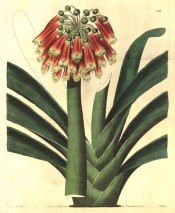Clivia nobilis Lindl.
Rhizomatous perennial, easily distinguished from the common Clivia miniata by its longer, narrower strap-shaped leaves and umbels of 40-60 semi-pendant tubular red and yellow flowers, tipped with green, in spring, the scapes 40cm or more in height. [RHSE, Hortus].
Horticultural & Botanical History
First botanically described by John Lindley in 1828. ‘This noble plant is supposed to have been one of the discoveries of Mr. Bowie at the Cape of Good Hope, from some of the inner districts of which colony it was probably procured. The plant from which our drawing was made, flowered for the second time in July last, in the princely garden of his Grace the Duke of Northumberland, at Syon House.’ [BR f.1182/1828].
It was described and figured in the same year in the Botanical Magazine by William Hooker under the name of Imatophyllum aitonii. ‘Mr. Bowie, who so successfully explored the Botany of Southern Africa, and enriched the Royal Gardens at Kew with many of its choicest productions, in the summer of last year, immediately previous to his return to the Cape, mentioned to me a Cyrtanthus-like plant, which he had there found and imported, and which, if it blossomed in this country, he desired might bear the Specific Name of his patron, Mr. Aiton. At the same time, the letter enclosed one or two of the wild specimens of the flowers, and a small piece of the leaf; from which it was evident that, however closely allied the plant might be to Cyrtanthus, it could not rank in the same Genus. A specimen having flowered in October of last year, in the noble gardens at Sion House, Mr. Forrest, under whose skilful charge is placed the whole of those truly princely collections, kindly requested His Grace the Duke of Northumberland’s permission for a drawing to be made of the plant, from which, the accompanying figure is copied. Mr. Aiton has likewise been so obliging as to send me a drawing and specimens of the fruit, with the particulars of its habitat, extracted from Mr. Bowie's notes : “on shaded spots, near Quagga flats, and more common in the Albany tracts, near the great Fish River.” ’ [BM t.2856/1828].
‘We are informed by Mr. Lindley [that he] named it in compliment to Her Grace the Duchess of Northumberland.’ [LBC no.1906/1835]. Clivia nobilis was the first Clivia to be introduced to Europe, by Dr. Burchell in 1828.
History at Camden Park
Listed in the 1845, 1850 and 1857 catalogues [B.68/1845]. Imantophyllum aitonii was included in a consignment of plants sent from Kew by John Bidwill in November 1843 [AJCP]. This is a possible source. Camden Park is today famous for the large number of Clivia miniata naturalised there, but this species was a later introduction, date unknown. Another Clivia was introduced in the 1860s or 1870s, from the nursery of Ambroise Veerschaffelt, Ghent, under the name Clivia cyrtanthiflora. This plant, a hybrid between nobilis and miniata and more properly called Clivia x cyrtanthiflora (Van Houtte) Traub, is also prominent in the gardens scattered among the miniata in large mature clumps easily distinguished from them, even when not in flower, by its more robust growth, longer, narrower leaves, reminiscent of Agapanthus, and nobilis-like flowers. This plant has been confused in Australia with Clivia nobilis and is often given the common name ‘Aussi nobilis’. Clivia nobilis is the only species known to have been grown at Camden before 1863 but was then lost from the gardens. It has recently been re-introduced.
Notes
Published Apr 25, 2009 - 01:54 PM | Last updated Jun 26, 2012 - 04:41 PM
| Family | Amaryllidaceae |
|---|---|
| Category | |
| Region of origin | South Africa |
| Synonyms |
|
| Common Name | Drooping clivia, Natal clivia, Green tip kaffir lily |
| Name in the Camden Park Record | Clivia nobilis
|
| Confidence level | high |


